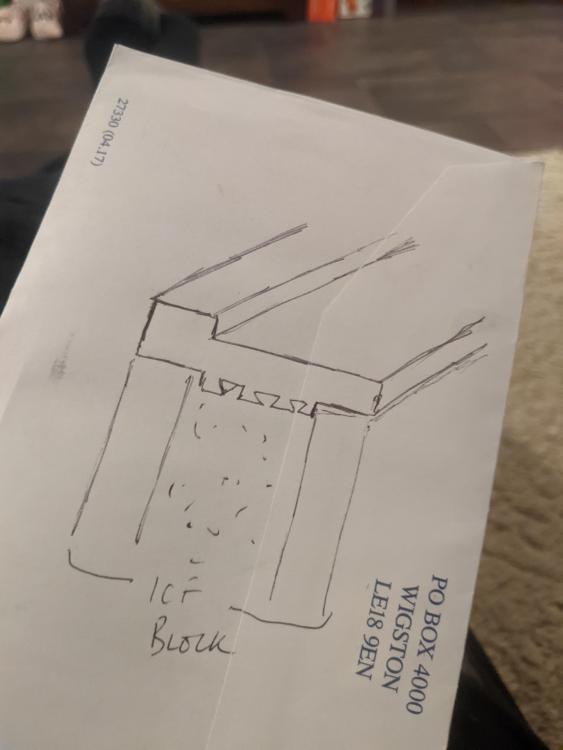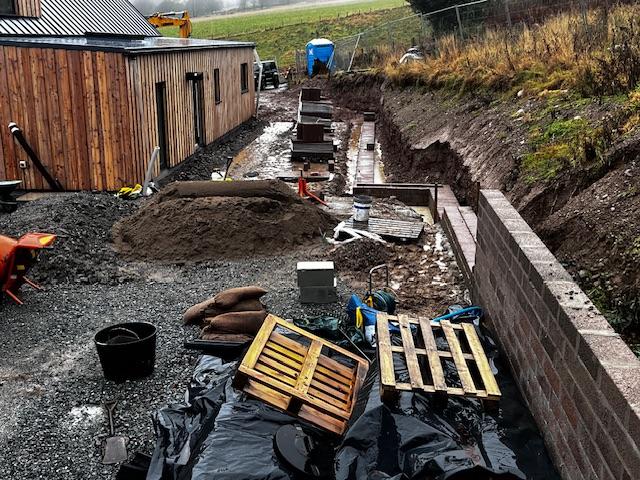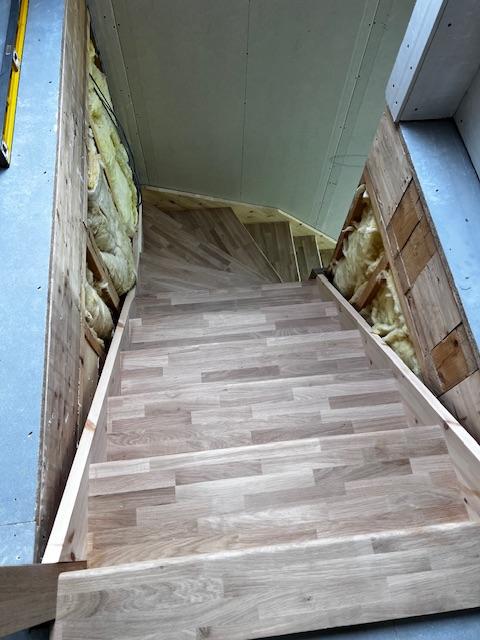Leaderboard
Popular Content
Showing content with the highest reputation on 12/15/23 in all areas
-
2 points
-
Hello @NoelM. Welcome. What stage - and why - did the builder walk? I ask because it'll help us help you.2 points
-
I agree, we've basically been working with a system set up by the 1936 Public Health Act and tweaked a bit by the 1984 Building Act where an applicant was only "giving notice of an intention to build" . A council (as it was then) could refuse an application but that didn't stop work going ahead if the applicant wanted as long as work on site complied. That was all well when things were simple and building methods were traditional. Now we have really complex regulations about saving energy, electric vehicles, gigabyte infrastructure and goodness knows what else. You can't check that on site standing in the rain and mud.2 points
-
Faulty foundations apparently... https://www.bbc.co.uk/news/articles/cv2548v1dpyo1 point
-
On the upside, the Cambridge neck of the woods have challenging soils, not run of the mill stuff, exciting but you need to have your wits about you when entering this den of underground terrain.. not common bed time reading but for the keen. Cambridge lies roughly on the edge of the Gault CLAY formation. It's a thin band of a particular soil that stretches from Swafham, East of King's Lynn, thickens (on plan) aproaching Cambridge to Oxford, thins out and ends just to the east of Bath. At the Bath end it tends to be a bit less expansive as it is siltier and more sandy... but at the northern end (Cambridge end) is becomes a wolf in sheep's clothes. I'm trying to introduce some drama as it's nearly Santa time. The Gault clay can trip you up as when you dig as it can appear quite firm / hard. But when the weather changes is becomes a highly expansive soil. This can trip builders and designers up. It is quite a unique soil for the UK and in a thin and variable band so not often encountered. I can in some ways see why maybe design changes were possibly made late or on site. Now there may a be a bit more to this as Gault clay can also contain elevated levels of suphuric acid and sulphates that can attack concrete... and all that impacts on any steel rebar reinforcement in terms of rebar cover. It may be that the heave thing is exacerbated by the durability of the concrete and rebar cover. Maybe someone has said.. hey it's not just the heave thing but your cement content in the concrete / rebar cover is under spec for the soil type. Now that would impact on any concrete piling potentially. Anyway. At least no one has got hurt, it has been picked up, a lot of folk will have learnt some lessons.. the insurer's will pick it up and we the punters will pick up the tab one way or another.1 point
-
1 point
-
A bizarre twist to this, is those on pre payment meters won't get this surcharge as they can't go into debt. And already the prices of PPM have been levelled so it is not more expensive. Perhaps en-mass we should all switch to pre payment meters? Like I suspect most consumers I pay the same amount each month building up a credit in the summer to pay for the higher usage in winter. Does that not qualify as "pre payment"? If I did, as a matter of protest switch to a PPM it would mean me paying less in summer and more in winter. Is this a "solution" they really want?1 point
-
I am not terminating all twisted pairs from the Cat6A cables around the house, just the ones that I will be using. the plan is to bring the Cat6A cables. the plan is to bring them in at the top left of the cabinet and terminate them there in the 8-way blocks. in fact it will, I hope, be very similar to @joth's photo from where this screen shot has been taken I'm pretty certain that I'll regret some of my decisions with layout and wiring etc as I've not done this before. but I will live and learn and if I need to redo it at some point in the future then so be it!1 point
-
In normal operation you shouldn't hear bypassing water, as the UFH starts to close down, it should start to open. The valve volume increases as the valve is just about closed, then goes silent once completely closed. Sounds like your pump setting was ok.1 point
-
I can hear the water slowly flowing past the bypass valve right now. If I increase (turn towards the 0.50) a little I can hear it flowing much more. I should not hear any flow?? I adjusted the pump to the mid flow setting. Less and the head pressure is at 2.7 meter and flow is way too low.1 point
-
It is the builder's responsibility/ fault, or their designer. BC do not do detailed checks of the design, otherwise they would need a lot more staff, who happen to know absolutely everything, and many times the fee. They do an overview of the design*, and sampling checks on site. They can't even do spot checks without an invitation from the builder. We're all guessing about this project, as it could be any of many things. Error in the soils assessment. A recent change in the ground condition. Design error. Change of design by the builder. Construction faults. Construction quality. Has anyone noticed in the blurb, why they changed to a in-situ suspended slab? Or how this is done for a ground floor? This appears to have been quoted as the problem. I'm not aware of an economic way of doing this, ie in getting the shuttering out again after use. So perhaps it was poured on the ground for ease, and isn't actually suspended. I'm speculating again. * A Structural Engineer may do many days of detailed consideration and complex design. BC would need to have an SE in house who specialised in that ( or those) aspects of design, or they have to commission another SE to do so. They do NOT go through all the calculations. They look at the principles, and take a view on whether the output/ proposal looks about right. Anther important aspect that often isn't understood is 'Building Notice'. In the English system it is permitted to submit designs as the project proceeds. This is higher risk, and can lead to projects not being considered holistically, and construction proceeding in advance of stage approvals. As a designer and contractor I preferred this, as it allows an earlier start, and I know it is my risk. A 'Full plans' application needs all the detail and I think is unusual for big projects, because of the time delay for approval. Which is better? It depends on the contractor's skill and attitude to risk. In Scotland there is no option. Having recently worked with the Scottish system, we had to wait a very long time for the warrant to be issued. It is a serious offence to start without approval. Much as the wait for approval is frustrating, it did allow additional details to be submitted or even changes made to ensure the bco's approval. They pointed out some issues that might have been contentious, and they were resolved before commencement.1 point
-
Welcome, not good about the builder. Post your question the appropriate area, keep each question to the point, otherwise you will get a lot of varied responses.1 point
-
3.8m.is .38bar, plus piping pressure losses, so it's likely the pump is just pushing the bypass open. You should be able to here it passing. Get everything up and running and slowly increase the setting until you cannot hear it passing. You should also adjust pump speed, reduce setting until flow rates at the UFH drop a little.1 point
-
with awesome help from @Rob99, @joth, @Dan F, @jack, @Kelvin and many many others I have finally come up with a design for my Loxone cabinet ready for it to be ripped apart by those same amazing folk! 🤣 it's quite small as I had to zoom out in the spreadsheet to fit it all in but hopefully you can zoom in and see what everything is. very welcome to hear comments.1 point
-
A site visit won't tell you if you need piles. There would need to be a site investigation which is then given to a SE who advises on the correct foundations. BC can only sign off on the paperwork provided. I do agree though that large developers get much less oversight than individual builders, yet individual builders are probably more likely to take care that their build is being done correctly.1 point
-
BC very rarely signs off or even visits developers site. I think it should be mandatory.1 point
-
I used an impact adhesive in the end - this stuff: https://www.toolstation.com/evo-stik-contact-adhesive/p95550?utm_source=googleshopping&utm_medium=feed&utm_campaign=googleshoppingfeed&mkwid=_dc&pcrid=null&pkw=null&pmt=null&gad_source=1&gclid=EAIaIQobChMI4-Sox92RgwMVzMbtCh0TygmIEAQYAyABEgJMPvD_BwE&gclsrc=aw.ds Seemed to do the trick, less so on the cut PIR but seemed to hold sufficiently1 point
-
But maybe drilling a hole for a vertical loop would avoid this, and although expensive would still be cheaper and less disruptive than replacing the whole shebang.1 point
-
1 point
-
From the info you've provided, it's difficult to tell. Even if working correctly, the buffer temp at its centre will be cycling between flow and return temp, and there may be some lag in the Temp the sensor is reading as it's likely to be placed in a pocket on the buffer and not within the water itself. What's your distance between ASHP and Buffer? Is much of that distance outside? and how well insulated are the pipes? I'm trying to gauge what your losses may be. Since the HP is set to switch off at an LWT of 40°C, a well designed 4P Buffer would be almost fully charged at the point the LWT temp hits 40°, so the centre of the tank should show close to 40°C (ie. 40°C - losses in flow pipe), once the pocket and sensor have stabilised and as long as the heating circuit isn't circulating at that point. If the heating circuit is circulating the buffer will discharge and the temp will drop. At what point were you measuring the 31°C temp? and was it stable at that temp for say 10 mins? Your DHW is controlled differently, ie, by a temp sensor in the tank, or perhaps the return temp, so the HP LWT will exceed the UVC set point until it's temp requirement is met (potentially masking any losses in the flow/return pipes). The temp of the water in the UVC is also likely to be less transient than the buffer temp, so the gauge is more likely giving stable/accurate readings.1 point
-
Will be down to whoever designed the foundation system for that site. If they got their calculations wrong, then BC would probably be unable to check the numbers. In the rare case where someone 'gets confused' and says do A when they should have said do B, then that would be down to whoever is responsible for that site, probably the building company. Will really come down to a paper trail to find out where the mistake was made. What is important is that mistakes like this are spotted before any physical work takes place.1 point
-
No special tools required, just a screwdriver to insert into the release hole on the Wago blocks and to push the release button on the Weissmuller 8 level. Solid core cables should push into the wago without any hassle, stranded (e.g. tri-rated cabinet wiring) should be fitted with bootlace ferrules. As the 8 level blocks use smaller gauge wire I find it best to push the button first then insert the cable.1 point
-
No. Thicker solid-core cable just push-in, if thinner though it can be helpful to push down the release "button" (with a small screwdriver) at the same time as pushing cable in. This way you avoid the thin AWG23 core bending as you try to push it in. Looks like the the Wago's have a recessed release "button". but you'll still be fine with a small flat-head screwdriver unless you want to get the Wago "operating tool" https://www.wago.com/gb/tools/operating-tool/p/2009-309 Is everything solid core? If you have stranded cables it's best practice to terminate these with bootlace ferrules first, even though the terminal blocks do support stranded. Note that with standard cables and ferrules the maxumum core size is 2.5mm2 instead of 4mm2 for the Wago, but that should be plently. This info, along with strip lengths in the datasheet.1 point
-
Bad luck. Are you going to appeal or fresh application? Sometimes the appeal can be useful to pin down which refusal grounds are relevant, so any subsequent application can focus on addressing those. It all takes time though!1 point
-
Why do you need 3 phase? And yes where does the 200A come from? 100A is easy, standard domestic consumer units and switchgear.1 point
-
You can only really do it with thick screed and use it as a storage heater. Over charge the floor you are hot all day, under charge you are cold all day. It's a fine balance to get it right. You need to stop heat input earlier than you think as well1 point
-
How is buffer plumbed in 2 ports or 4 ports? And where are you measuring temperature on the buffer? Really you set it for weather compensation, to get the best economy out the heat pump. A set flow temp could be cost you money on anything the coldest day.1 point
-
1 point
-
I'm confused by this question. Do you already have three phase? If so just put 3 CUs on it, one per phase. Do you want to meter each phase separately? Where does the 200amp 3phase requirement come from? Ability to go off grid depends a lot on you daily load and tolerance for occasional outage. 30kWh battery wouldn't get us (family of 2) through the winter without regular blackouts.1 point
-
I'm using Yay.com They do a free 14 day trial. iirc it was around £25 to port a number. I'm impressed with the service, even for their lowest cost option. Loads of storage for voicemail and call recording. The voice-to-text transcripts are pretty good too that gets emailed and stored on the account, when voicemails are left.1 point
-
They have had to go back to planning committee to get the demolition process added to the reserved matters approvals for the method statements for construction (as presumably they only allowed for building them, not knocking them down). The proposed method statement includes for demolishing the structure whilst salvaging as much as possible for re-use. It also mentions grubbing out the foundations with all brickwork/concrete being crushed on site and re-used to fill voids and for piling mats. The attached plan (presented to committee so in the public domain) shows the plots to be taken down but interestingly refers to adjacent piled houses remaining. It therefore seems to be a situation where some were piled and are ok but some had traditional foundations and are not. There are no specific details probably because someone's PI insurance is going to get a very big hit. plan.pdf1 point
-
Found it. It's all in this report from July and worth a read if you're into ground heave. https://darwingreenconstruction.co.uk/frequently-asked-questions/ In principle though. There has been soil heave due to the high plasticity of the ground. Phase 1, had beam and block suspended flooring and seems to have resisted, or joggled with, ground movement. Phase 2. is in-situ suspended concrete floors, which has 'not allowed for' the heave, resulting in cracking. I also notice that the Buiding control was by NHBC, and there is no comment about inspections. And that the Environment Agency are against further development as there is insufficient water supply, and it will deplete the aquifer.1 point
-
Fit a threshold / Aco channel drain all along the porch and affected areas. Make sure it has somewhere to drain to that's effective.1 point
-
I was more thinking about spammers joining and wasting time. Though we are pretty good at catching them out.1 point
-
Quite right. PM would be the better contact. In his case though, it isn't an alias, so his website and number are readily available in a search. Unless of course, it is all a cover story and that isn't his real name. I don't think it would take MI5 long to work out who anybody on here is.1 point
-
I removed your phone number @Gus Potteras the big bad world is full of strange people who can cause trouble. If @ash_scotland88wants your number he can PM you.1 point
-
I have been incredibly fortunate! My installer, who I rate very highly, was able to convince LG that because of the expense of paying him to carry out a repair under warranty, which is very time consuming with a refrigerant leak, it was better to supply a new heat pump. So now I have the latest version of the Therma V with improved controls and I have to learn about all the new features. I still can't quite believe it.1 point
-
1 point
-
Our nice clean dry site is now a muddy hole. I decided that we needed to extend the retaining wall all the way down the bank. I noticed that it never really fully dried out in the summer and the silt was running off it onto the drive. Original plan was to grade it back to the other wall and grass it but it just looked a bit unfinished and I was a bit concerned about it shifting over time. We’ll put drainage in behind it and tie it into the main drain. It’s also allowed us to widen the driveway by almost a metre. It was a little tight before once we’d built the wheelchair access. Brickies started this morning and back tomorrow. Will be finished by Monday night.1 point
-
It was indeed a doddle! Plasterboard behind and under stairs done.1 point
-
We measured it to allow us to slide the plasterboard behind it should be a doddle. 😂1 point
-
1 point
-
The key is the planning officer. If he recommends approval and gets voted down you are virtually guaranteed a win on appeal.1 point
-
Cast iron rule. You attend. Cast iron rule. You make your case. Cast iron rule. You make every single word of the case count. Cast iron rule. You practice what you want to say in front of a competent Critical Friend. Cast Iron rule. Make them reject you , dont by your absence make it easy for them to reject you.1 point
-
0 points
-
0 points
-
The Minister responsible doesn't understand the situation, neither does his PPS or the PPs' pps, neither could they give a flyin' fookety fook. Not going to be there more than a few minutes more are they...0 points
-
Well I feel sorry for the poor sod who'll end up being the only one left paying for everyone's electricity use.......0 points
-
It was rejected, but on the criterion that I wanted to test (whether they valued heritage over eco-goodness). We had one chap on our side, and I managed to not make a total dog's dinner of the speech, so that was something. On the whole the committee were pretty reasonable, and whilst I think the "emotional sell" definitely helped, there were fundamental issues that our proposal had which they couldn't ignore. It was a good experience, and we also got a bit more insight into the thinking of the planning officers, ready for the next scheme. It'll go up on YouTube for a limited time, so I'll post the link here in case you want to watch me fluff my lines.0 points
-
I mulled a giant solar thermal array and glycol filled loop with insulation under the path / drive. It's just a pipe dream though...0 points














